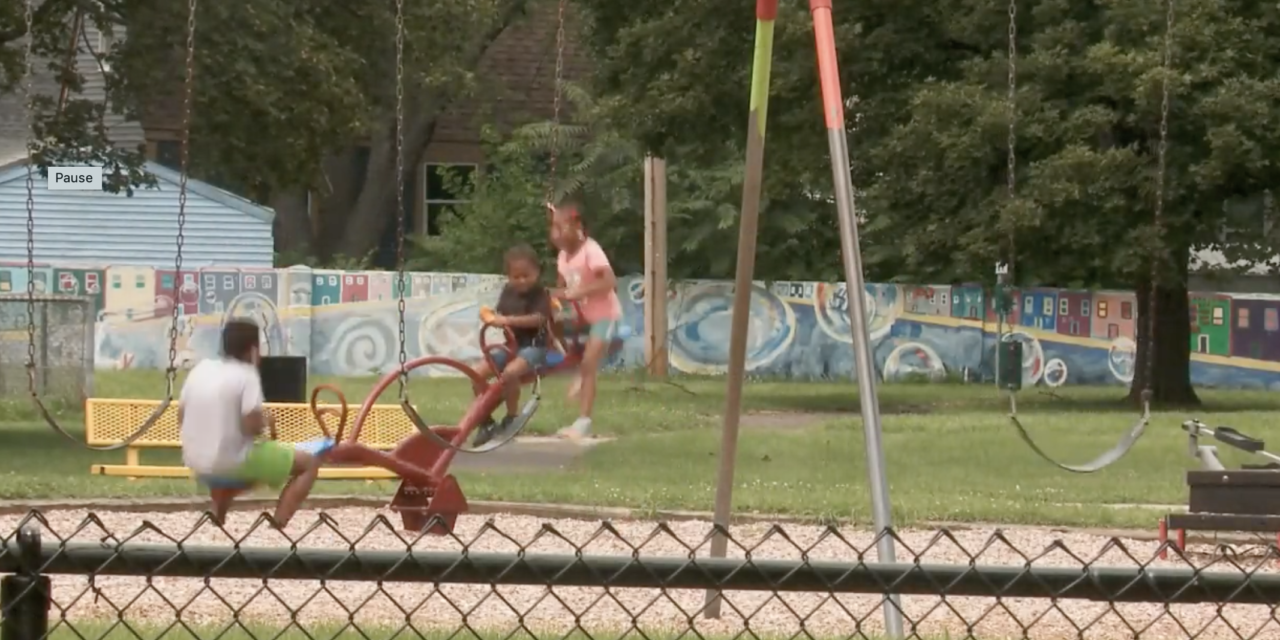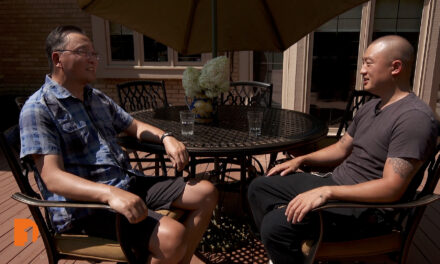Originally posted on August 12, 2021
A simple cinder block wall, built 80 years ago, where it still stands at Detroit’s northern border just off Eight Mile Road, west of Wyoming Avenue.
It’s been called the Wailing Wall, the Eight Mile Wall and the Birwood Wall because it went up along Birwood Street, a lasting symbol of racism during the war years when Detroit became America’s Arsenal of Democracy.
One Detroit’s partner BridgeDetroit along with NBC News did some extensive new reporting on the legacy of the wall, talking to people that lived in that neighborhood.
Olivia Lewis of BridgeDetroit learned more about African Americans who settled near Eight Mile and Wyoming before the area was annexed by the city of Detroit and the reason the wall was built. Lewis said, “We talk about a family who comes to Detroit, sets up their own neighborhood essentially and is fighting for housing rights and access to housing early on and to see that play out over decades I think is very important.”
The wall became a dividing line that allowed a developer to get federal funding for homes to be built for white people.
For Gerald Van Dusen, the Birwood Wall ties into other events that happened during the war years. At that time there was a fight in the city’s northeast side over the federal government’s Sojourner Truth Housing Project, intended for Black families. Nearby white residents tried to stop them from moving in, leading to a riot that made headlines nationwide.
At the Packard plant, white workers walked off the line when the company promoted some African Americans. Van Dusen has written books about the wall and the housing riot. “The Birwood Wall incident, the Sojourner Truth Incident, and then the hate strikes at the Packard plant and other factory plants really precipitated the race riot of 1943, the biggest riot of the war,” he wrote.
“When we were getting started on this project, we were trying to figure out well, okay, who built the wall?” NBC News reporter Erin Einhorn said, ”We talked to experts, and nobody seemed to know.” Einhorn would find the developer was a prominent Detroiter from a prominent Michigan family.
One Detroit’s Bill Kubota gets the inside scoop from reporters and author Gerald Van Dusen about the wall and what it means to Detroiters eight decades later.
Full Transcript:
Erin Einhorn: If you see it today you just assume you know it’s there for decorative purposes.
A CINDER BLOCK WALL WITH A FEW DIFFERENT NAMES: THE WAILING WALL; THE BIRWOOD WALL; THE EIGHT MILE WALL – IT’S JUST SOUTH OF EIGHT MILE ROAD – BUILT BY A REAL ESTATE DEVELOPER TO SEPARATE PEOPLE BY RACE 80 YEARS AGO.
Torre May: I thought about it a lot.
TORRE MAY’S BEEN HERE FOR 20 YEARS.
Torre May: It just makes you angry.
ONE DETROIT PARTNER BRIDGE DETROIT TEAMED UP WITH NBC NEWS TO TELL THE WALL’S STORY, WHICH CAUGHT FORMER DETROITER JOHNNIE SMITH’S EYE.
SHE’S WITH HER CHILDREN VISITING FROM CALIFORNIA.
Johnnie Smith: Actually there was a write-up about the Eight Mile Wall and I thought it would be very interesting to have the kids come and see how Detroit was segregated not many years ago.
ERIN EINHORN AND OLIVIA LEWIS SPENT SIX MONTHS INVESTIGATING THE LEGACY OF THE WALL.
Bill Kubota: How did you get on to the story in the first place?
Erin Einhorn: Yeah, it was actually last summer during the height of the protests and George Floyd had been killed and there were all these other viral videos and we were really struck by how differently people were viewing these events, like completely different lenses, specifically white folks were viewing it very differently than black folks. We were trying to find out why is it, why is that and it’s actually pretty obvious why that is, like here in one of the most diverse countries in the world most Americans live in a segregated neighborhood.
IN 1941 A DEVELOPER HAD TO KEEP HIS HOUSES SEPARATE FROM AN ADJACENT BLACK NEIGHBORHOOD TO GET A GOVERNMENT LOAN.
UP WENT THE WALL BETWEEN BIRWOOD AND MENDOTA STREETS – THE EMBODIMENT OF RED-LINING – LENDING MONEY BUT LEAVING OUT AFRICAN AMERICANS.
MORE RECENTLY ELIZABETH WARREN MADE A CAMPAIGN STOP HERE AND GERALD VAN DUSEN WROTE A BOOK ABOUT IT.
Bill Kubota: Do you think most Detroiters know about this wall?
Gerald Van Dusen: Most people living on Mendota and Birwood don’t know about the origins of the wall. That’s what I found quite stunning. People are so used to when they moved in this concrete backing, they assumed it was a lot like the kind of barriers you see maybe behind stores you know running east and west on Eight Mile.
Olivia Lewis: I knew about the wall, my mom had told me about the wall when I was younger because she grew up in a neighborhood close by.
Erin Einhorn: My family also has ties to the neighborhood. My father grew up half a mile south of the wall. In fact some of the people we interviewed for the story were my father’s elementary school classmates and this was for me a pretty revealing discovery, I think all of the white folks we interviewed, none of them knew the wall was there when they were kids growing up.
Bill Kubota: There’s been stories done about this wall before but yours had some new information that probably was a revelation to a lot of people in Detroit.
Olivia Lewis: You know I think that one of the things that’s really interesting about our story, what makes it a little bit different is that there is this ongoing story about one family.
THE CREWS FAMILY CAME FROM ALABAMA IN 1918 TO THE AREA NEAR EIGHT MILE ROAD – IT WAS GREENFIELD TOWNSHIP BACK THEN.
THEY SETTLED HERE IN A TAR PAPER SHACK.
Olivia Lewis: We talk about a family who comes to Detroit, sets up their own neighborhood essentially and is fighting for housing rights and access to housing early on and to see that play out over decades I think is very important.
Erin Einhorn: When we were getting started on this project we were trying to figure out well okay who built the wall and we talked to experts and nobody seemed to know. This was surprising because the wall, as you said has it’s gotten a lot of attention in recent years but missing from that narrative has been who built the thing?
A DIVE INTO THE ARCHIVES REVEALED THE DEVELOPER – A PROMINENT DETROITER FROM A PROMINENT FAMILY, EVEN TODAY.
Erin Einhorn: James T McMillan and his two sons were the people who built the wall. His grandfather, James T McMillan’s grandfather who represented Michigan around the turn of the Twentieth Century.
Olivia Lewis It’s important to know who is behind things so you can go back and how history played out. I think that people want to know not only who is responsible but to hold people accountable and see how can we move forward, how have we moved forward and so I don’t necessarily see it from a standpoint of blame but how can we learn from this and do better.
DURING THE WAR DETROIT ATTRACTED MORE FACTORY WORKERS CAUSING A MASSIVE HOUSING SHORTAGE.
AS THE BIRWOOD WALL WENT UP, SO TOO THE SOJOURNER TRUTH FEDERAL HOUSING PROJECT – MEANT FOR AFRICAN AMERICAN WAR PRODUCTION WORKERS ON THE NORTHEAST SIDE.
TROUBLE WAS, WHITE PEOPLE SHOWED UP WHEN THEY TRIED TO MOVE IN.
Bill Kubota: That particular incident, the riot. Maybe that is even lost to history for a lot of people in Detroit.
Gerald Van Dusen: Pretty much, pretty much lost as well. It still stands and I went over there one day fairly recently and I was talking to the current manager of public housing unit. They had no idea of the history of that structure and what had taken place during the war years.
GERALD VAN DUSEN WROTE A BOOK ABOUT THE SOJOURNER TRUTH RIOT TOO – A RIOT INSTIGATED IN PART BY A PRIEST AT A NEARBY POLISH CATHOLIC CHURCH.
Gerald Van Dusen: And the arrests were of primarily of Blacks even though whites were doing just as much of the pushing and pulling and rock-throwing and the like.
AS THE COUNTRY UNITED AGAINST THE GERMANS AND JAPANESE, IN DETROIT, THE ARSENAL OF DEMOCRACY, A FIGHT WAS ON TO KEEP SOCIETY SEGREGATED.
Gerald Van Dusen: And the rules simply said this: that if you’re going to put up housing, if the neighborhood is predominantly Black then the housing will be exclusively Black, if its predominantly white it’ll be exclusively white, if it’s a mixed neighborhood, well theoretically it could be mixed but never was it mixed, it was going to be one or the other and typically it was in a mixed neighborhood it was white.
SOJOURNER TRUTH BECAME A RALLYING CRY – A CONFLICT OVER HOUSING AND RACE HEARD NATIONALLY.
Gerald Van Dusen: The Birwood Wall incident, the Sojourner Truth Incident, and then the hate strikes at the Packard plant and other factory plants really precipitated the race riot of 1943, the biggest riot of the war.
Erin Einhorn: You know I was driving recently down a broad boulevard that had a grassy median down the middle right near the border of Detroit and Grosse Pointe and thinking like oh I understand why this was here but a lot of those broad boulevards with grassy medians were built for exactly the same reasons this wall was built. We have all these legacies in all these different places and we may not even know they’re there.
Subscribe to One Detroit’s YouTube Channel & Don’t miss One Detroit Mondays and Thursdays at 7:30 p.m. on Detroit Public TV, WTVS-Channel 56.
Catch the daily conversations on our website, Facebook, Twitter @DPTVOneDetroit, and Instagram @One.Detroit
View Past Episodes >
Watch One Detroit every Monday and Thursday at 7:30 p.m. ET on Detroit Public TV on Detroit Public TV, WTVS-Channel 56.





